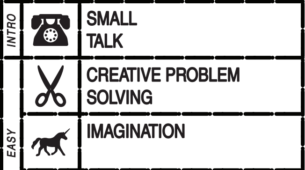For this week’s Critical Play, I played Factory Balls, developed by Bart Bonte. The game is available on iOS, Android, Windows, MacOS, and any web browser. I played the web version, which I enjoyed having the option to be able to do for the sake making it easy to start playing. The game is suitable for any age, but the intended audience is someone who loves puzzles or anyone who wants a fun logic challenge.

Factory Balls is a puzzle game that uses deceptively simple mechanics to create an experience rooted in experimentation, sequence recognition, and lateral thinking. The core loop involves taking a blank ball and transforming it via paint, gear, hat, or belt until it matches a visual target. Each level is a new design brief. The challenge? The tools and their effects stay consistent, but the logic needed to achieve the goal evolves.

Unlike puzzle games that rely on overt storytelling, Factory Balls strips narrative away, focusing entirely on mechanics. This minimalist design is a strength because it allows the puzzle mechanics to shine. Each action (putting on sunglasses, dipping a ball in blue paint, or planting grass) is self-explanatory after one use. The brilliance lies in how these actions interact. The game cleverly stacks complexity by introducing tools one at a time and combining them in increasingly unexpected ways. For instance, you might need to first grow grass, then cover part of the ball with a belt, then apply pesticide only to the exposed section. This is an effective method of design because it allows players to experiment and learn the tools, resulting in an “aha” moment on each level.

Still, there’s room for improvement. The game sometimes requires very specific sequences of actions that feel more like trial-and-error than deduction. For example, a level might need you to paint over an already-colored section without a clear signal that layering was necessary. While this maintains challenge, it can occasionally break flow. Compared to games like Portal which signpost necessary mechanics in each puzzle while still allowing for surprise, Factory Balls leaves players more alone in the learning process. While this may have been the intended design, if the audience of this game is puzzle lovers, then it seems important to have a game design that they can reasonably complete first try if they deduce well enough.
From a formal elements standpoint, the game’s objective is consistent (make the ball match the picture), and the procedures (drag tools onto the ball) remain the same throughout. The player gets no score, no time limit, just the intrinsic satisfaction of solving the puzzle. This supports the fun of mastery and challenge rather than competition or chance.

Each mechanic (masking, dipping, rotating) feeds into a tight feedback loop. If you get something wrong, the visual cue is immediate. The clean UX and forgiving resets foster a mindset of exploration over punishment. In this way, the game evokes the same kind of logic found in programming or real-world prototyping: try, observe, and iterate.
Factory Balls turns problem-solving into play by creating a space where trial-and-error feels like progress, not punishment. Its minimalist design and clever mechanics allow for deep cognitive engagement, though it could be more inclusive in its assumptions about players’ knowledge and perception. It’s a standout example of how puzzle mechanics are the game, and how satisfying it can be when those mechanics click.
Ethics:
On an ethical level, Factory Balls seems neutral considering it includes no language, no characters, and no clear cultural cues. But even then, the question of a player’s assumed knowledge is present. The puzzles rely heavily on an understanding of visual patterns, spatial reasoning, and even some basic color theory. This slightly favors players with formal education or exposure to certain STEM-related thinking. It also assumes visual clarity. For example, colorblind players might struggle since there’s no text-based alternative or symbol system to distinguish between paints. Additionally, while the controls are simple, the idea of masking and layering isn’t intuitive to all, especially younger players or those unfamiliar with visual editing software or crafts.
Overall, while the game presents itself as universally accessible, it subtly privileges certain cognitive and perceptual styles. Designers could make the game more inclusive with optional hints, colorblind modes, or alternative puzzle pathways that teach mechanics more gradually.



